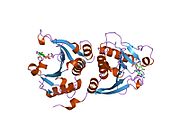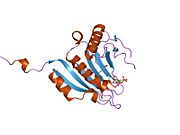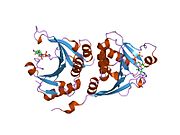EIF4E
Ensembl | |||||||||
|---|---|---|---|---|---|---|---|---|---|
| UniProt | |||||||||
| RefSeq (mRNA) | |||||||||
| RefSeq (protein) | |||||||||
| Location (UCSC) | Chr 4: 98.88 – 98.93 Mb | Chr 3: 138.23 – 138.27 Mb | |||||||
| PubMed search | [3] | [4] | |||||||
| View/Edit Human | View/Edit Mouse |


Eukaryotic translation initiation factor 4E, also known as eIF4E, is a protein that in humans is encoded by the EIF4E gene.[5][6]
Structure and function
Most
The other subunits of eIF4F are a 47-kD polypeptide, termed eIF4A,[8] that possesses ATPase and RNA helicase activities, and a 220-kD scaffolding polypeptide, eIF4G.[9][10][11]
Some viruses cut eIF4G in such a way that the eIF4E binding site is removed and the virus is able to translate its proteins without eIF4E. Also some cellular proteins, the most notable being heat shock proteins, do not require eIF4E in order to be translated. Both viruses and cellular proteins achieve this through an internal ribosome entry site in the RNA or through other RNA translation mechanisms such as those going through eIF3d[12][13]
eIF4E plays roles outside of translation and other cap-binding proteins can engage in cap-dependent translation in an eIF4E-independent manner including factors such as eIF3D, eIF3I, PARN, the nuclear cap-binding complex CBC.[14][15][12][16][17][13][18] Many of these appear to be dependent on both specific features of transcripts as well as cellular context.
eIF4E is found in the nucleus of many mammalian cell types as well as in other species including yeast, drosophila and humans.[19][20][21][22][23][24][25][26] eIF4E is found in nuclear bodies a subset of which colocalize with PML nuclear bodies, and eIF4E is additionally found diffusely in parts of the nucleoplasm in mammalian.[23][21][24][25][27][28][26] In the nucleus, eIF4E plays well defined roles in the export of selected RNAs which contributes to its oncogenic phenotypes.[29][21][24][25][27][28][30][31][32][33] This relies on the ability of eIF4E to bind the m7G cap of RNAs and the presence of the 50 nucleotide eIF4E sensitivity element (4ESE) in the 3’UTR of sensitive transcripts; although other elements may also play a role. This form of export relies on the CRM1/XPO1 pathway.[21][24][27][34][35][26] Nuclear eIF4E has been shown to play other roles in RNA processing including in m7G capping, alternative polyadenylation and splicing.[36][37][38]
Increased nuclear accumulation of eIF4E as well as increased eIF4E-dependent RNA export, m7G capping and splicing of selected transcripts is characteristic of high-eIF4E AML patient samples.[25][30][38][37] RNAs are selected based on USER codes, or cis-acting elements, within their RNAs for specific levels of RNA processing; thus not all transcripts are sensitive to all levels of regulation (including translation).[35][39][18] For its RNA export function, eIF4E directly binds to the leucine rich pentatricopeptide repeat protein (LRPPRC) which directly binds the dorsal surface of eIF4E and simultaneously to the 4ESE RNA thereby acting as a platform for assembly for the RNA export complex.[26][35] The current model is then LRPPRC binds to CRM1/XPO1 to engage the nuclear pore and traffic the 4ESE RNA to the cytoplasm.[28][26][35] In all, the nuclear functions of eIF4E can have potent impacts on the proteome allowing eIF4E to both re-write the message as well as to increase production of proteins based on increased accumulation in the cytoplasm due to increased export as well as to increased number of ribosomes per transcript in some cases. Its multiple roles in RNA processing require its association of RNAs through the m7G cap, and thus eIF4E can be considered a cap-chaperone protein.
Regulation
Since eIF4E is an initiation factor that is relatively low in abundance, eIF4E can be controlled at multiple levels.[40][18] Regulation of eIF4E may be achieved at the levels of transcription, RNA stability phosphorylation, subcellular localization and partner proteins.[41]
a. Regulation of eIF4E by Gene Expression and RNA stability
The mechanisms responsible for eIF4E transcriptional regulation are not entirely understood. However, several reports suggest a correlation between myc levels and eIF4E mRNA levels during the cell cycle.[42] The basis of this relationship was further established by the characterization of two myc-binding sites (CACGTG E box repeats) in the promoter region of the eIF4E gene.[43] This sequence motif is shared with other in vivo targets for myc and mutations in the E box repeats of eIF4E inactivated the promoter region, thereby diminishing its expression.
Recent studies shown that eIF4E levels can be regulated at transcriptional level by NFkB and C/EBP.[44][45] Transduction of primary AML cells with IkB-SR resulted not only in reduction of eIF4E mRNA levels, but also re-localization of eIF4E protein.[25] eIF4E mRNA stability are also regulated by HuR and TIAR proteins.[46][47] eIF4E gene amplification has been observed in subset of head and neck and breast cancer specimens.[48]
b. Regulation of eIF4E by Phosphorylation
Stimuli such as hormones, growth factors, and mitogens that promote cell proliferation also enhance translation rates by phosphorylating eIF4E.[49] Although eIF4E phosphorylation and translation rates are not always correlated, consistent patterns of eIF4E phosphorylation are observed throughout the cell cycle; wherein low phosphorylation is seen during G0 and M phase and wherein high phosphorylation is seen during G1 and S phase.[50] This evidence is further supported by the crystal structure of eIF4E which suggests that phosphorylation on serine residue 209 may increase the affinity of eIF4E for capped mRNA.
eIF4E phosphorylation is also related to its ability to suppress RNA export and its oncogenic potential as first shown in cell lines.[51]
c. Regulation of eIF4E by Partner Proteins
Assembly of the eIF4F complex is inhibited by proteins known as eIF4E-binding proteins (4E-BPs), which are small heat-stable proteins that block cap-dependent translation.[41] Non-phosphorylated 4E-BPs interact strongly with eIF4E thereby preventing translation; whereas phosphorylated 4E-BPs bind weakly to eIF4E and thus do not interfere with the process of translation.[52] Furthermore, binding of the 4E-BPs inhibits phosphorylation of Ser209 on eIF4E.[53] Of note, 4E-BP1 is found in both the nucleus and the cytoplasm, indicating that it likely modulates nuclear eIF4Es functions of eIF4E as well.[54] A recent study showed that 4E-BP3 regulated eIF4E dependent mRNA nucleo-cytoplasmic export.[55] There are also many cytoplasmic regulators of eIF4E that bind to the same site as 4E-BP1.
Many other partner proteins has been found that can both stimulate or repress eIF4E activity, such as homeodomain containing proteins, including HoxA9, Hex/PRH, Hox 11, Bicoid, Emx-2 and Engrailed 2.[56][24][57][58][59] While HoxA9 promotes mRNA export and translation activities of eIF4E, Hex/PRH inhibits nuclear functions of eIF4E.[25][60][61] The RNA helicase DDX3 directly binds with eIF4E, modulates translation, and has potential functions in P-bodies and mRNA export.[62][26]
RING domains also bind eIF4E. The promyelocytic leukemia protein PML is a potent suppressor of both the nuclear RNA export and oncogenic activities of eIF4E whereby the RING domain of PML directly binds eIF4E on its dorsal surface suppressing eIF4E's oncogenic activity; and moreover a subset of PML and eIF4E nuclear bodies co-localize.[63][21][64][23][24][28] RNA-eIF4E complexes are never observed in PML bodies consistent with the observation that PML suppresses the m7G cap binding function of eIF4E.[21][64][28] Structural studies show that a related arenavirus RING finger protein, Lassa Fever Z protein, can similarly bind eIF4E on the dorsal surface.[64][65][66]
eIF4E nuclear entry is mediated by its direct interactions with Importin 8 where Importin 8 associates with the m7G cap-binding site of eIF4E.[32] Indeed, reduction in Importin 8 levels reduce the oncogenic potential of eIF4E overexpressing cells and its RNA export function. Importin 8 binds to the cap-binding site of eIF4E and is competed by excess m7G cap analogues as observed by NMR. eIF4E also stimulates the RNA export of Importin 8 RNA thereby producing more Importin 8 protein. There may be additional importins that play this role depending on cell type. Although an initial study suggested that the eIF4E transporter protein 4E-T (eIF4ENIF1) facilitated nuclear entry, later studies showed that this factor rather alters the localization of eIF4E to cytoplasmic processing bodies (P-bodies) and repress translation.[67]
Potyvirus viral protein genome linked (VPg) were found to directly bind eIF4E in its cap-binding site. VPg is covalently linked to its genomic RNA and this interaction allows VPg to act as a "cap."[68][69][16][70] The potyvirus VPg has no sequence or structural homology to other VPg's such as those from poliovirus. In vitro, VPg-RNA conjugates were translated with similar efficiency to m7G-capped RNAs indicating that VPg binds eIF4E and engages the translation machinery; while free VPg (in the absence of conjugated RNA) successfully competes for all the cap-dependent activities of eIF4E in the cell inhibiting translation and RNA export.[70]
d. Regulation of eIF4E cellular localization
Several factors that regulate eIF4E functions also modulate the subcellular localization of eIF4E. For instance, overexpression of PRH/Hex leads to cytoplasmic retention of eIF4E, and thus loss of its mRNA export activity and suppression of transformation.[24] PML overexpression leads to sequestration of eIF4E to nuclear bodies with PML and decrease of eIF4E nuclear bodies containing RNA, which correlates to repressed eIF4E dependent mRNA export and can be modulated by stress.[21][23][25] Overexpression of LRPPRC reduces eIF4E’s co-localization with PML in the nucleus and leads to increased mRNA export activity of eIF4E. As discussed above, Importin 8 brings eIF4E into the nucleus and its overexpression stimulates the RNA export and oncogenic tranformation activities of eIF4E in cell lines. Transduction of primary AML cells with IkB-SR resulted not only in reduction of eIF4E mRNA levels, but also re-localization of eIF4E protein.[25]
The Role of eIF4E in Cancer
The role of eIF4E in cancer was established after Lazaris-Karatzas et al. made the discovery that over-expressing eIF4E causes tumorigenic transformation of fibroblasts.[71] Since this initial observation, numerous groups have recapitulated these results in different cell lines.[72] As a result, eIF4E activity is implicated in several cancers including cancers of the breast, lung, and prostate. In fact, transcriptional profiling of metastatic human tumors has revealed a distinct metabolic signature wherein eIF4E is known to be consistently up-regulated.[73]
eIF4E levels are increased in many cancers including acute myeloid leukemia (AML), multiple myeloma, infant ALL, diffuse large B-cell lymphoma, breast cancer, prostate cancer, head and neck cancer and its elevation generally correlates with poor prognosis.[30][74][75][76][77][78][79][80] In many of these cancers such as AML, eIF4E is enriched in nuclei and several of eIF4E’s activities are found to be elevated in primary patient specimens, including capping, splicing, RNA export, and translation.
In the first clinical trials targeting eIF4E, old antiviral drug ribavirin was used as a m7G cap competitor which had substantial activity in cancer cell lines and animal models associated with dysregulated eIF4E.[81][82][75][31][83][84][85][78][86][87][88][89][90][80] In the first trial to ever target eIF4E, ribavirin monotherapy was demonstrated to inhibit eIF4E activity leading to objective clinical responses including complete remissions in AML patients.[30] Interestingly, relocalization of eIF4E from the nucleus to the cytoplasm correlated with clinical remissions indicative of the relevance of its nuclear activities to disease progression.[30] Subsequent ribavirin trials in AML in combination with antileukemic drugs again showed objective clinical responses including remissions and molecular targeting of eIF4E.[76][91] Clinical responses correlated with reduced nuclear eIF4E and clinical relapse with re-emergence of eIF4E nuclear eIF4E and its RNA export activity in these AML studies. Other studies used ribavirin in combination showed similar promising results in head and neck cancer.[79] Ribavirin impairs all of the activities of eIF4E examined to date (splicing, capping, RNA export and translation). Thus, eIF4E has been successfully therapeutically targetable in humans; however drug resistance to ribavirin is an emergent problem to long term disease control.[84][76][91]
eIF4E has also been targeted by antisense oligonucleotides which were very potent in mouse models of prostate cancer,[92] but in monotherapy trials in humans did not provide clinical benefit likely due to the inefficiency of reducing eIF4E levels in humans compared to mice.[93] There is also an allosteric inhibitor of eIF4E which binds between the cap-binding site and the dorsal surface that is used experimentally.[94]
FMRP represses translation through EIF4E binding
Fragile X mental retardation protein (
In addition, FMRP may recruit CYFIP1 to specific mRNAs in order to repress translation. The FMRP-CYFIP1 translational inhibitor is regulated by stimulation of neuron(s). Increased synaptic stimulation resulted in the dissociation of eIF4E and CYFIP1, allowing for the initiation of translation.[95]
Interactions
EIF4E has been shown to
. Other direct interactors: PML;[21][64] arenavirus Z protein;[64][63][65][66] Importin 8;[32] potyvirus VPg protein,[70] LRPPRC,[35][26] RNMT[117] and others.
See also
References
- ^ a b c GRCh38: Ensembl release 89: ENSG00000151247 – Ensembl, May 2017
- ^ a b c GRCm38: Ensembl release 89: ENSMUSG00000028156 – Ensembl, May 2017
- ^ "Human PubMed Reference:". National Center for Biotechnology Information, U.S. National Library of Medicine.
- ^ "Mouse PubMed Reference:". National Center for Biotechnology Information, U.S. National Library of Medicine.
- PMID 1916814.
- S2CID 10683455.
- PMID 291969.
- S2CID 35343626.
- PMID 20702611.
- PMID 3469651.
- ^ "Entrez Gene: eIF4E Eukaryotic translation initiation factor 4E".
- ^ PMID 30076308.
- ^ PMID 27462815.
- PMID 26942679.
- PMID 27401559.
- ^ PMID 32496897.
- PMID 32873578.
- ^ PMID 34944805.
- PMID 1384058.
- PMID 10648556.
- ^ PMID 11500381.
- S2CID 17404294.
- ^ PMID 12167712.
- ^ PMID 12554669.
- ^ PMID 14645512.
- ^ PMID 19262567.
- ^ PMID 15837800.
- ^ PMID 17074885.
- PMID 8577715.
- ^ S2CID 28957125.
- ^ PMID 23471078.
- ^ PMID 27114554.
- PMID 29111978.
- PMID 26603836.
- ^ PMID 28325843.
- PMID 31042468.
- ^ PMID 33055213.
- ^ PMID 36843541.
- S2CID 58587801.
- PMID 3793730.
- ^ S2CID 4347657.
- PMID 8327497.
- PMID 8756633.
- PMID 22851180.
- PMID 23467026.
- PMID 16537914.
- PMID 19114552.
- S2CID 776478.
- PMID 2191953.
- PMID 3038908.
- S2CID 21104713.
- PMID 25702871.
- PMID 8662663.
- PMID 18515545.
- S2CID 40980342.
- PMID 12368268.
- PMID 15247416.
- PMID 16267555.
- PMID 16136508.
- PMID 15578431.
- PMID 15657436.
- S2CID 19781838.
- ^ PMID 12438698.
- ^ PMID 11575918.
- ^ PMID 11792829.
- ^ PMID 20212144.
- PMID 16157702.
- PMID 18705846.
- PMID 30242622.
- ^ PMID 31712417.
- S2CID 4366949.
- PMID 25593033.
- S2CID 12059602.
- PMID 20049173.
- ^ PMID 21415224.
- ^ PMID 25425688.
- PMID 25717031.
- ^ PMID 25422161.
- ^ PMID 28963790.
- ^ PMID 30478448.
- PMID 15601771.
- PMID 16251386.
- PMID 23583375.
- ^ PMID 24870236.
- PMID 26317515.
- PMID 27932243.
- S2CID 21655102.
- PMID 29049978.
- S2CID 49634908.
- S2CID 73419809.
- ^ S2CID 257733013.
- PMID 17786246.
- PMID 21831956.
- PMID 25049413.
- ^ S2CID 14123165.
- S2CID 14892764.
- ^ PMID 17353931.
- ^ PMID 16648488.
- S2CID 4427026.
- ^ PMID 7651417.
- PMID 16242075.
- S2CID 30113895.
- S2CID 5023204.
- PMID 12071973.
- ^ PMID 10753870.
- PMID 10698949.
- PMID 10364159.
- PMID 11605658.
- PMID 18957614.
- S2CID 4360955.
- S2CID 24527449.
- PMID 9593750.
- PMID 10856257.
- S2CID 4516850.
- PMID 16541103.
- PMID 9418880.
- PMID 35026230.
Further reading
- Jain S, Khuri FR, Shin DM (2004). "Prevention of head and neck cancer: current status and future prospects". Current Problems in Cancer. 28 (5): 265–86. PMID 15375804.
- Culjkovic B, Topisirovic I, Borden KL (2007). "Controlling gene expression through RNA regulons: the role of the eukaryotic translation initiation factor eIF4E". Cell Cycle. 6 (1): 65–9. PMID 17245113.
- Malys N, McCarthy JE (2010). "Translation initiation: variations in the mechanism can be anticipated". Cellular and Molecular Life Sciences. 68 (6): 991–1003. S2CID 31720000.
External links
- Cap-dependent translation initiation from Nature Reviews Microbiology. A good image and overview of the function of initiation factors.
This article incorporates text from the United States National Library of Medicine, which is in the public domain.








